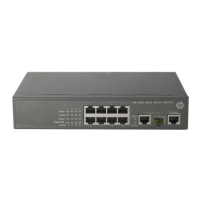Task Description
Configuring an uplink policy
Required
Configures an uplink policy for the customer-side port.
Configuring the customer-side port
Required
Configures VLAN and other settings required for many-to-one
VLAN mapping.
Configuring the network-side port
Required
Configures VLAN and other settings required for many-to-one
VLAN mapping.
Configuration prerequisites
Create CVLANs and SVLANs, and plan CVLANs-to-SVLAN mappings.
Configuring an uplink policy
Follow these steps to configure an uplink policy to map a group of CVLANs of the same customer to one
SVLAN:
To do... Use the command... Remarks
Enter system view system-view —
Configure a class for a group of
CVLANs
• Create a class and enter class view
traffic classifier tcl-name operator or
• Configure multiple CVLANs as match criteria
if-match customer-vlan-id { vlan-id-list | vlan-id1
to vlan-id2 }
Required
Return to system view quit —
Configure a behavior for an
SVLAN
• Create a traffic behavior and enter traffic
behavior view
traffic behavior behavior-name
• Configure an SVLAN marking action
remark service-vlan-id vlan-id
Required
Return to system view
quit —
Create a QoS policy and enter
QoS policy view
qos policy policy-name Required
Map the CVLANs to the SVLAN by
associating the class with the
behavior
classifier tcl-name behavior behavior-name mode
dot1q-tag-manipulation
Required
Configuring the customer-side port
Follow these steps to configure the customer-side port:
To do... Use the command... Remarks
Enter system view system-view —
Enter Ethernet interface view
interface interface-type
interface-number
—
159

